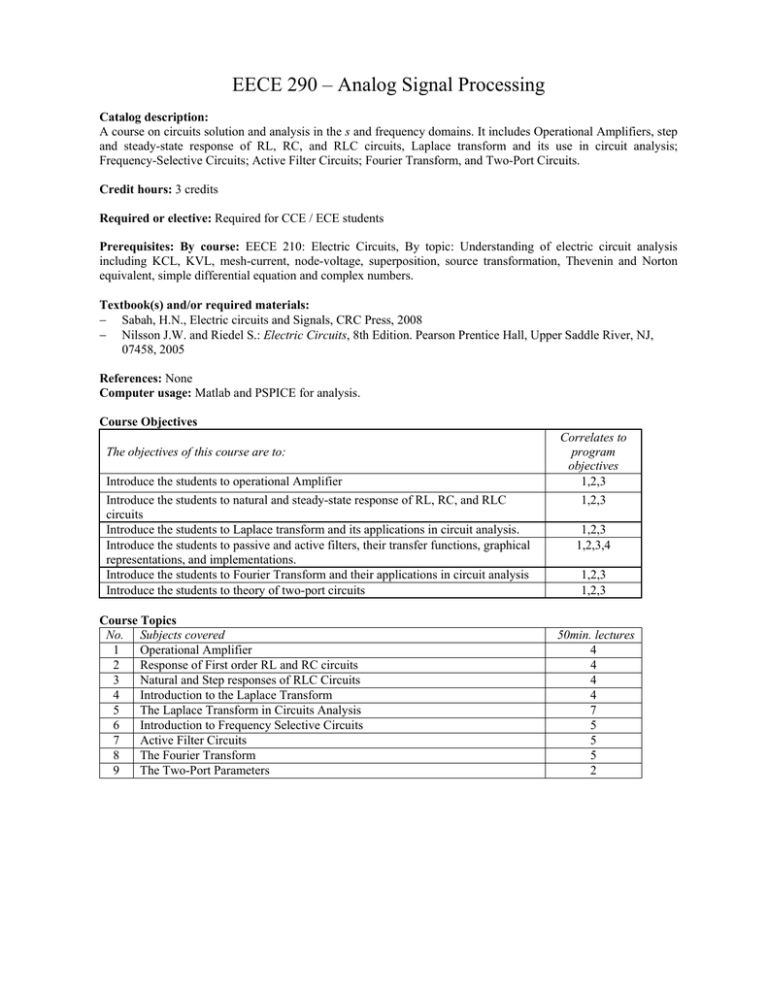
EECE 290 – Analog Signal Processing
Catalog description:
A course on circuits solution and analysis in the s and frequency domains. It includes Operational Amplifiers, step
and steady-state response of RL, RC, and RLC circuits, Laplace transform and its use in circuit analysis;
Frequency-Selective Circuits; Active Filter Circuits; Fourier Transform, and Two-Port Circuits.
Credit hours: 3 credits
Required or elective: Required for CCE / ECE students
Prerequisites: By course: EECE 210: Electric Circuits, By topic: Understanding of electric circuit analysis
including KCL, KVL, mesh-current, node-voltage, superposition, source transformation, Thevenin and Norton
equivalent, simple differential equation and complex numbers.
Textbook(s) and/or required materials:
− Sabah, H.N., Electric circuits and Signals, CRC Press, 2008
− Nilsson J.W. and Riedel S.: Electric Circuits, 8th Edition. Pearson Prentice Hall, Upper Saddle River, NJ,
07458, 2005
References: None
Computer usage: Matlab and PSPICE for analysis.
Course Objectives
The objectives of this course are to:
Introduce the students to operational Amplifier
Introduce the students to natural and steady-state response of RL, RC, and RLC
circuits
Introduce the students to Laplace transform and its applications in circuit analysis.
Introduce the students to passive and active filters, their transfer functions, graphical
representations, and implementations.
Introduce the students to Fourier Transform and their applications in circuit analysis
Introduce the students to theory of two-port circuits
Course Topics
No. Subjects covered
1
Operational Amplifier
2
Response of First order RL and RC circuits
3
Natural and Step responses of RLC Circuits
4
Introduction to the Laplace Transform
5
The Laplace Transform in Circuits Analysis
6
Introduction to Frequency Selective Circuits
7
Active Filter Circuits
8
The Fourier Transform
9
The Two-Port Parameters
Correlates to
program
objectives
1,2,3
1,2,3
1,2,3
1,2,3,4
1,2,3
1,2,3
50min. lectures
4
4
4
4
7
5
5
5
2
Course Learning Outcomes
At the end of the course, students should be able to:
Understand the Operational Amplifier and how it can be used to
built an inverting-Amplifier, a noninverting-Amplifier, a
Summing Amplifier, and a difference-Amplifier Circuits.
Understand natural and step responses of an RL, RC, and RLC
circuits.
Understand the Laplace Transform and its use in circuit analysis.
Understand the concept of transfer function and system stability.
Understand the relation between impulse response, transfer
function, and convolution integrals.
Understand frequency Selective Circuits.
Understand the concept of design and analysis of active filters.
Understand the Fourier transform and its application in circuit
analysis.
Understand of the concept, analysis, and interconnection of twoport circuits.
* H: High correlation, M: Medium correlation, L: Low correlation
Class/laboratory schedule: Three 50-minute lectures per week.
Evaluation methods
1. Drop Quizzes:
2. Quiz 1:
3. Quiz 2:
4. Final:
10%
25%
25%
40%
Professional component
Engineering topics:
General education:
Mathematics and basic sciences:
60%
10%
30%
Person(s) who prepared this description and date of preparation
Prepared by Ghassan Dib on April 2009
Date of last revision
Revised by Karim Kabalan on April 2009
Correlates to program
outcomes*
H
M
L
(a), (e),
(n)
(a), (e),
(n)
(a), (e),
(n)
(a), (e),
(n)
(a), (e),
(n)
(a), (e),
(n)
(a), (e),
(n)
(a), (e),
(n)
(a), (e),
(n)
(m), (k)
(m)
(m)
(m)
(m), (o)
(m)
(m), (k)
(m)
(m)


